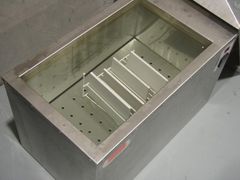Water Absorption Testing
Water absorption testing standards AS4459.3, Determination of water absorption, apparent porosity, apparent relative density and bulk density provides the means to classify ceramic tiles along with their method of manufacture according to AS 4662 Ceramic tiles – Definitions, classification, characteristics and marking. This is important when assessing the requirements that the ceramic tiles must achieve for them to be are considered the best commercial quality, otherwise known as first quality.
There are 2 methods to determine the water absorption of the ceramic tiles:
- Boiling method; and
- Vacuum method
The boiling method is used to classify the ceramic tiles and involves drying the tiles out and then boiling them in water for 2 hours followed by cooling to room temperature over a four hour period. The mass of the tiles are weighed both before and after the water immersion to determine the percentage of water absorption.
The vacuum method evacuates the air from a chamber with the tiles inside and then immerses the tiles in water. Once again the tiles are weighed before and water immersion to determine the apparent porosity, apparent relative density and bulk density.
In general terms, if the tile has low water absorption, the durability and strength are increased. Low water absorption restricts the amount of water that may cause failure by cyclic salt attack and freeze thaw.
These low water absorption ceramic tiles are generally referred to as fully vitrified, impervious and porcelain. There terms are synonymous exhibit water absorption of less than 0.5% when tested to AS4459.3, Determination of water absorption, apparent porosity, apparent relative density and bulk density.
While generally fully vitrified, impervious and porcelain are viewed by the consumer as superior products, it does not guarantee that the material is fit for purpose. Hence the requirements for other test methods in the Australian Standards AS 4662.

